Study Guide 5: Action Potentials
1/54
There's no tags or description
Looks like no tags are added yet.
Name | Mastery | Learn | Test | Matching | Spaced |
|---|
No study sessions yet.
55 Terms
What is a graded potential?
A local change in membrane potential
The resting membrane potential of a neuron is negative. If the membrane potential is
made even more negative, we can say the neuron has been hyperpolarized/depolarized.
hyperpolarized
If the membrane potential is made less negative, the neuron has been hyperpolarized/depolarized
depolarized
Which type of graded potential describes a change in membrane potential from...
−70 to −60 mV? hyperpolarizing/depolarizing [pick one]
−70 to −80 mV? hyperpolarizing/depolarizing [pick one]
depolarizing
hyperpolarizing
A graded potential occurs when a stimulus causes mechanically gated or ligand-gated channels to open or close in an excitable cell's plasma membrane.” Why would opening ion channels lead to a change in the membrane potential?
It changes the permeability of the membrane so more ions can flow into or
out of the cell. The movement of charges changes Vmem
What factors influence the size of a graded potential
How many channels are open, and for how long
Why does the graded potential spread?
At the spot where the graded potential occurs, an ionic gradient forms. Gradients = flow!
What happens to the graded potential as it spreads away from the initial site?
it gets weaker
What happens to the graded potential over time?
gets weaker until it disappears
Summation is the process by which graded potentials are added together. Briefly explain what this means in your own words.
If there are two graded potentials that emerge on different parts of the membrane, if they both have the same type of polarization effect, the total effect becomes a sum of its parts, and the graded potential becomes stronger.
During the depolarizing phase of an action potential, the membrane gets more positive/more negative
more positive
During the repolarizing phase of an action potential the membrane gets more positive/more negative
more negative
What are the 1st channels to open during an action potential?
voltage gated Na channels
Why would opening these Na channels cause the membrane to depolarize?
Sodium has an electrochemical driving force that drives it into the cell. More sodium channels mean more permeability, AKA less resistance to flow. As more sodium flows in, the inside of the cell get more positive because sodium is a positive ion
What are the 2nd channels to open during an action potential
Voltage-gated K channels
Why would opening K channels cause the membrane to repolarize?
Potassium has an electrochemical driving force that drives it out of the cell. More K+ channels means more permeability, AKA less resistance to flow. As more potassium flows out, the inside of the cell gets more negative because K is a positive ion
Why is the membrane potential of a cell lower immediately after an action potential
than it normally is at rest?
Higher-than-resting permeability (leak channels AND some voltage-gated K+ channels are all
open) to K+ lets V mem get even closer to Ek
How does the strength of a depolarizing stimulus affect the amplitude (max depolarization) of an action potential?
no effect
What does it mean when people say that an action potential is an “all-or-none”/“all-or-
nothing” phenomenon?
You either get an AP or you don’t. No half-an-action-potential
What happens to voltage-gated sodium channels at the threshold potential?
How and why does this change the membrane potential?
it activates, which lets in sodium and membrane potential goes up
What are the two gates on a voltage gated sodium channel
activation and inactivation gate
which gate opens in response to depolarization of the plasma membrane
activation
which gate closes in response to membrane depolarization
inactivation
During an action potential, a threshold-level change in voltage/membrane potential
causes voltage-gated sodium channels and voltage-gated potassium channels to open.
Why does the cell’s permeability to sodium increase before the permeability to
potassium does?
Voltage-gated sodium channels open faster
At the molecular level, what two events lead to the switch from the depolarization
phase to the repolarization phase?
Voltage-gated sodium channels inactivate; Voltage-gated potassium channels open
How do the absolute and relative refractory periods differ concerning the strength of
a stimulus needed to trigger another action potential?
Refractory can be overcome by a stronger stimulus, absolute cannot
What is the molecular basis for the absolute refractory period?
How about the relative refractory period?
Voltage-gated sodium channels are inactivated and therefore cannot reopen
High permeability to K makes it harder to get back to the threshold
Why are action potentials an example of positive feedback?
An initial depolarization sets off a chain of events that amplifies the depolarization
An action potential initiated at the axon hillock travels in one direction (away
from the cell body, toward the synaptic terminals). Why doesn’t it propagate backward?
The region of membrane behind the AP “wavefront” has just fired and AP and is in the absolute refractory period
How is saltatory conduction different from continuous conduction?
Saltatory conduction, where action potentials jump from nodes of ranvier is faster and more efficient. The depolarization spreads farther, and faster along the axon where it is myelinated, triggering another AP at an adjacent node. The relay continues
Why do action potentials spread faster along large-diameter axons? (Think about what
variables affect flow rate!)
less resistance
Why do action potentials spread faster along myelinated axons?
The AP “leaps” from node to node
Generally, why do intra/extracellular ion concentrations change influence neuronal
excitability? (Summarize in one or two sentences).
It changes the concentration gradient, which affects V mem (neuron is closer/farther from threshold, to begin with) and the rate of flow when channels do open (bigger gradient = faster flow rate)
How to get a larger stimulus
Keep open for longer
Reopen channels before they fully close
Open neighboring channels
We often care about the summation of graded potentials at the axon hillock. Why?
It is where action potentials start; there are many voltage-gated sodium channels. If graded potential moves to axon hillock, it can start an action potential.
The axon hillock has a high density of voltage-gated sodium channels which will open if Vmem is increased
to a threshold ( ~-55 mV). Sub-threshold depolarization
Depolarization of the cell membrane opens the _________________ gate of voltage-gated sodium channels. This causes ______________________, which opens __________________, which causes ______________________...
activation gate
depolarization
more Na channels
more depolarization
(depolarization) Opening ____ channels dramatically increases the permeability of the cell membrane to _____, which drives the membrane potential closer to ____ as the flow rate of _____ into the cell increases
Na+
sodium
ENa
Na+
Why does Vmem stops increasing well before ENa is reached?
The inactivation gate of a voltage-gated sodium channel closes in response to depolarization. This is slower than the activation gate. Inactivation gate doesn’t reset until Vmem returns to a negative value.
Vmem rapidly repolarizes to a negative potential when _______________ channels open. This is around the same time that _________________ channels inactivate
potassium
sodium
(repolarization)Opening ____ channels dramatically increases the permeability of the cell membrane to _____, which drives the membrane potential closer to ____ as the flow rate of _____ out of the cell increases
Kv
potassium
EK
K+
Permeability chart for sodium and potassium
red - sodium
blue - potassium
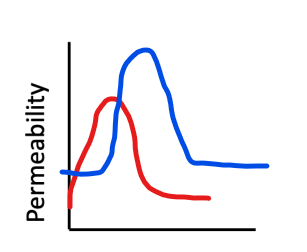
After an AP, the Vmem is briefly lower than the typical RMP (very close to EK). Why?
Because leak channels and Voltage gated channels for K+ are open, allowing more K+ to flow out than normal
Even during an action potential, the number of ions that cross the membrane is minimal compared to the total number of ions inside and outside the cell. So, as long as the Na/K pump is running, the [ion]inside and [ion]outside ___________________________.
does not appreciably change

Describe each part
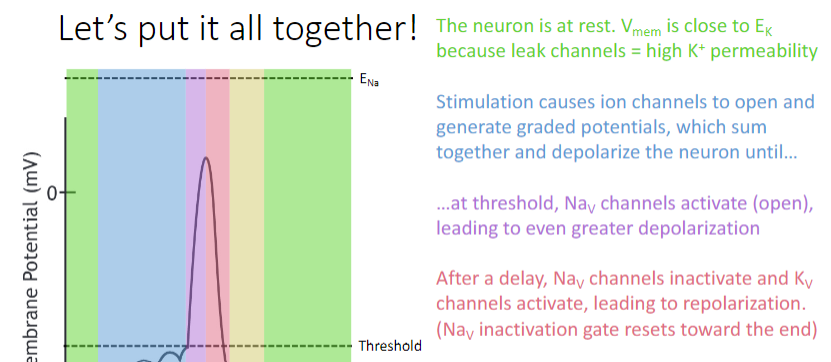
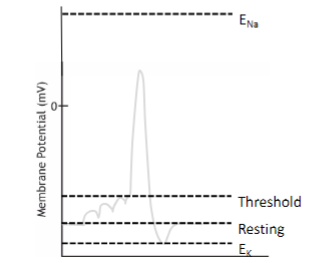
what would the action potential look like if a drug were added to the neurons which prevented voltage-gated K+ channels from opening.

While ____ channels are still open, a stronger
stimulus is required to trigger another AP. This is called the ____.
Kv
relative refractory period
It is _____ to trigger another action potential during the relative refractory period.
harder but possible
The strength of a sustained stimulus is reflected by
the frequency of action potentials firing....to a certain extent. What is that extent?
The Na V channel inactivation gates must reset
for the channels to be able to reopen
This is called the absolute refractory period.
It is impossible to trigger another action potential.
The strength of the stimulus does not matter.
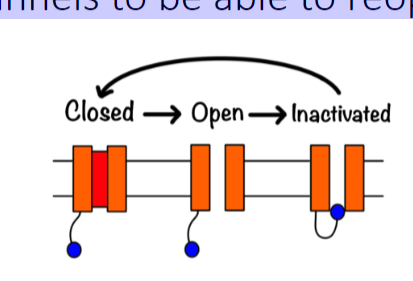
How does an AP travel down the axon?
An action potential in one part of the axon triggers an action potential in the adjacent membrane An AP “travels” down an axon in the same way the wave “travels” through a stadium
Axon Hillock Axon terminal
Why doesn’t the AP backpropogate?
The region of the membrane behind the current would be in the absolute refractory period, and since the AP starts from the axon hillock, it has no choice but to move forward.
Myelination
Myelination speeds up propagation down the axon Myelin changes the electrical properties of axons The depolarization spreads farther distances more quickly, as if “leaping” from node to node Voltage-gated channels and Na + /K+ pumps are only present at nodes (more efficient!)
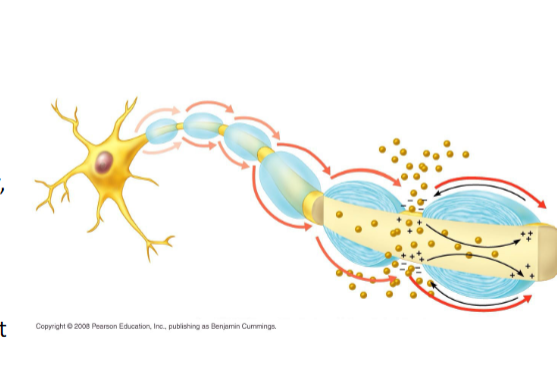
Myelin increases the ____ that the depolarization from a single AP can travel
distance
What is myelin made of
modified membrane of glial cells
Multiple Sclerosis
a disease which disrupts neuron myelination APs travel more slowly, or can even “die out” before they reach the next node
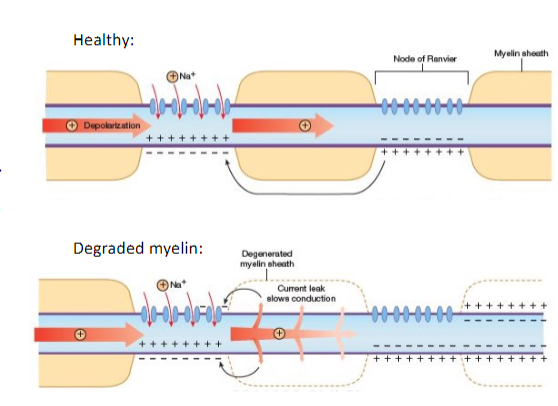
What would happen if you experimentally raised Vmem in the middle of axon to threshold?
The AP will propagate bidirectionally toward
the axon terminals and toward the cell body